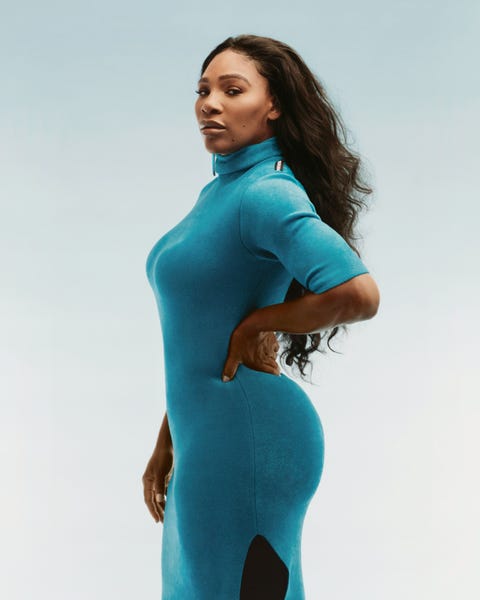Products You May Like
My body has belonged to tennis for so long. I gripped my first racket at age 3 and played my first pro game at 14. The sport has torn me up: I’ve rolled my ankles, busted my knees, played with a taped-up Achilles heel, and quit midgame from back spasms. I’ve suffered every injury imaginable, and I know my body.
When I found out I was pregnant two days before the 2017 Australian Open, my body had already switched allegiances. Its purpose, as far as it was concerned, was to grow and nurture this baby that had seemingly materialized, unplanned. Being pregnant wasn’t something I could tell Alexis over the phone; I told him to fly out to Melbourne right away. When he got here, I handed him a paper bag filled with six positive pregnancy tests I had taken all in one afternoon.
Of course, being pregnant didn’t mean I couldn’t play tennis. I was scheduled to compete at eight weeks along. I wasn’t sure how the Open would go; during training, I was getting more fatigued between points. Each morning—and I’m not a morning person to begin with—I was still determined to play fast and hard before the Melbourne heat socked me. I won seven matches, all in straight sets.
Since I’ve had my baby, the stakes of the game have shifted for me. I have 23 Grand Slams to my name, more than any other active player. But winning is now a desire and no longer a need. I have a beautiful daughter at home; I still want the titles, the success, and the esteem, but it’s not my reason for waking up in the morning. There is more to teach her about this game than winning. I’ve learned to dust myself off after defeat, to stand up for what matters at any cost, to call out for what’s fair—even when it makes me unpopular. Giving birth to my baby, it turned out, was a test for how loud and how often I would have to call out before I was finally heard.
Let’s go back to the beginning. My first trimester brought headaches and a weird metallic taste in my mouth, but all in all, I had a wonderful pregnancy. I guess I’m one of those women who likes being pregnant; I enjoyed the positive attention. I’m used to getting negative attention from the press and critics, but this was different. I settled into a whole new way of being. I was relaxed not playing: my life was just sitting at home, and it was wonderful. I still had plenty of work to do, but my focus narrowed to keeping myself healthy for the baby.
Don’t ask me why, but I was obsessed with having the baby in September, so I put off the doctors when they wanted to induce me in late August. I finally went in on August 31, and they inserted a little pill inside of me to get things going. Contractions started shortly after that, and it was great! I know that’s not what people are supposed to say, but I was enjoying it, the work of labor. I was completely in the moment. I loved the cramps. I loved feeling my body trying to push the baby out. I wasn’t on an epidural; to get through it, I was using my breath and all the techniques I’d learned from birth training (I had taken every birthing class that the hospital had to offer).
By the next morning, the contractions were coming harder and faster. With each one, my baby’s heart rate plummeted. I was scared. I thought I should probably get an epidural, but I was still okay with the work so I didn’t. Every time the baby’s heart rate dropped, the nurses would come in and tell me to turn onto my side. The baby’s heart rate would go back up and everything seemed fine. I’d have another contraction, and baby’s heart rate would drop again, but I’d turn over and the rate would go back up, and so on and so forth.
Outside my birthing room, there were meetings going on without me—my husband was conferencing with the doctors. By this point, I was more than ready for the epidural, but after 20 minutes, the doctor walked in, looked at me, and said, “We’re giving you a C-section.” She made it clear that there wasn’t time for an epidural or more pushing. I loved her confidence; had she given me the choice between more pushing or surgery, I would have been ruined. I’m not good at making decisions. In that moment, what I needed most was that calm, affirmative direction. Since it was my first child, I really wanted to have the baby vaginally, but I thought to myself, “I’ve had so many surgeries, what’s another one?” Being an athlete is so often about controlling your body, wielding its power, but it’s also about knowing when to surrender. I was happy and relieved to let go; the energy in the room totally changed. We went from this intense, seemingly endless process to a clear plan for bringing this baby into the world.
I was nervous about meeting my baby. Throughout my pregnancy, I’d never felt a connection with her. While I loved being pregnant, I didn’t have that amazing Oh my God, this is my baby moment, ever. It’s something people don’t usually talk about, because we’re supposed to be in love from the first second. Yes, I was a lioness who would protect her baby at any cost, but I wasn’t gushing over her. I kept waiting to feel like I knew her during pregnancy, but the feeling never came. Some of my mom friends told me they didn’t feel the connection in the womb either, which made me feel better, but still, I longed for it.
When I finally saw her—and I just knew it was going to be a girl, that was one thing I knew about her before we even had it confirmed—I loved her right away. It wasn’t exactly instantaneous, but it was there, and from that seed, it grew. I couldn’t stop staring at her, my Olympia.
I spent the night in the hospital with my baby in the room. When I woke up, she was nestled in my arms. The rest of my body was paralyzed. I couldn’t get out of bed because my legs were still numb, but it didn’t matter. Alexis and I sat there, alone with our new baby. It was surreal to feel the presence of this third person in the room. Who was this new little creature?
So much of what happened after that is still a blur. I may have passed out a few times. In my haze, I wondered if I should ask someone about my drip. In 2010, I learned I had blood clots in my lungs—clots that, had they not been caught in time, could have killed me. Ever since then, I’ve lived in fear of them returning. It wasn’t a one-off; I’m at high risk for blood clots. I asked a nurse, “When do I start my heparin drip? Shouldn’t I be on that now?”
The response was, “Well, we don’t really know if that’s what you need to be on right now.” No one was really listening to what I was saying. The logic for not starting the blood thinners was that it could cause my C-section wound to bleed, which is true. Still, I felt it was important and kept pressing. All the while, I was in excruciating pain. I couldn’t move at all—not my legs, not my back, nothing.
I began to cough. The nurses warned me that coughing might burst my stitches, but I couldn’t help it. The coughs became racking, full-body ordeals. Every time I coughed, sharp pains shot through my wound.
I couldn’t breathe. I was coughing because I just couldn’t get enough air. I grabbed a towel, rolled it up, and put it over my incision. Sure enough, I was hacking so hard that my stitches burst. I went into my first surgery after the C-section to get restitched.
After that, I thought, “Well, now we’re all set.” Little did I realize that this would be the first of many surgeries. I wasn’t coughing for nothing; I was coughing because I had an embolism, a clot in one of my arteries. The doctors would also discover a hematoma, a collection of blood outside the blood vessels, in my abdomen, then even more clots that had to be kept from traveling to my lungs. That’s what the medical report says, anyway. To me, it was just a fog of surgeries, one after another.
My husband left—to get food and shower back at the house—and this started a trend in which every time he’d try to leave, I’d wind up back in the operating room. I had to get a second surgery, and before he could get home, he had to come right back. When I woke up from that surgery, in the hospital room with my parents and my in-laws, I felt like I was dying. They were trying to talk to me, and all I could think was, “I’m dying, I’m dying. Oh my God.” I really thought I would faint. I got up somehow, and I went into the other room because I didn’t want my mom to worry. I didn’t want her to hear me; she’s the world’s biggest worrier.
In the other room, I spoke to the nurse. I told her: “I need to have a CAT scan of my lungs bilaterally, and then I need to be on my heparin drip.” She said, “I think all this medicine is making you talk crazy.” I said, “No, I’m telling you what I need: I need the scan immediately. And I need it to be done with dye.” I guess I said the name of the dye wrong, and she told me I just needed to rest. But I persisted: “I’m telling you, this is what I need.” Finally, the nurse called my doctor, and she listened to me and insisted we check. I fought hard, and I ended up getting the CAT scan. I’m so grateful to her. Lo and behold, I had a blot clot in my lungs, and they needed to insert a filter into my veins to break up the clot before it reached my heart.
Surgery number three. Something I never knew: Athletes have bigger veins. I was under for a long time because they couldn’t find a filter to fit in my veins. This filter that fits every other patient wouldn’t fit me.
Poor Alexis. He tried again to leave for a moment at home, but they found another blood clot. He was distraught—and the man needed a shower! But back to the hospital he went, and I went in for surgery number four. I went into the same operating room so many times that I started to say, “I’m baaaaaack!” each time they wheeled me in. Alexis—and I can barely say this without laughing myself into tears—gave up on trying to leave. He showered in the hospital room because he was terrified to walk out the door. He didn’t try again, and I didn’t have any more surgeries.
Needless to say, I was exhausted. Despite fighting for it, I didn’t like being on the heparin drip. I just wanted to be with my baby. I remained calm through it all, but afterwards, when everyone was retelling the story, I thought, “Wow, no wonder everyone was panicking.” My mother, my sister, my good friend Jill Smoller, my father — they were having their own mini heart attacks at my side. And I was just sitting there, telling the nurse what I needed. I had a totally different experience from everyone else. I was hiding my fear so well in the room that I didn’t even feel it, while other people were hiding their fear from me in another room. It’s a good thing I didn’t realize that I was doing so poorly—panicking would’ve made everything worse.
My personal OBGYN was amazing. She never made me feel dismissed. Another doctor was supposed to be checking in but I didn’t see him very much. In fact, I saw him only once.
In the U.S., Black women are nearly three times more likely to die during or after childbirth than their white counterparts. Many of these deaths are considered by experts to be preventable. Being heard and appropriately treated was the difference between life or death for me; I know those statistics would be different if the medical establishment listened to every Black woman’s experience.
A week later, I finally left the hospital with Olympia. In the span of seven days, I had gone through four surgeries back-to-back, including my C-section. My body, my entire being, was just so tired at that point. When I first got home, I couldn’t walk down the driveway. When I finally made it to a tree halfway down the driveway, it was a big hurdle for me. Everyone in my family cheered me on, telling me, “You’re doing so good!” They must’ve been aching on the inside, but they still all acted like nothing was wrong. My dad was so encouraging, saying, “Look, you did it!” This, after he coached me for years, all tough and relentless. I’m glad they didn’t let me see how bad it really was.
Despite my body’s wreckage—and the fact that I couldn’t get in much breastfeeding—connecting with Olympia at long last was amazing; it was both the reward and the validation for all I’d been through. I went from not being able to really imagine her in the womb to us being completely inseparable. I still feel like I have to be around her for every day of her life, as much as possible. I’m anxious when I’m not around her. Honestly, it’s a little much!
Olympia has a great sense of humor. If you tell her to draw a bunny, she’ll draw a chicken instead, and she knows she’s making a joke. She loves to laugh. I thought I was going to be really strict, but so far I’m the more lenient parent. This kid has me under her finger. I didn’t know what kind of mom I’d be, and I still don’t know. Instead, maybe for the first time in my life, I’m just being.
This article appears in the April 2022 issue of ELLE.
Adapted from Arrival Stories: Women Share Their Experiences of Becoming Mothers, an anthology collected by Amy Schumer and Christy Turlington Burns, out April 5.
This article appears in the April 2022 issue of ELLE.



